Nagorno-Karabakh conflict: 'Execution' video prompts war crime probe
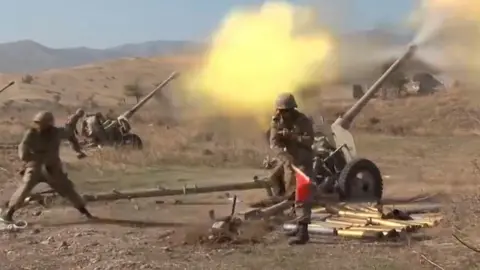 EPA
EPAVideos of a potential war crime have emerged as fighting rages around the disputed territory of Nagorno-Karabakh between Azerbaijan and ethnic Armenians.
One video posted on a messaging app shows what appears to be two Armenians in military uniforms being captured by troops from Azerbaijan.
A second video seemingly shows the same Armenians being shot with their hands behind their backs.
Armenian authorities have identified the men as Benik Hakobyan, 73, and 25-year-old Yuri Adamyan. Azerbaijan has dismissed the videos as fake.
Europe's top human rights watchdog, the Council of Europe, has said it has received the video and will look into all alleged human rights abuses and take action when appropriate.
Fighting erupted on 27 September around the Caucasus enclave, which is recognised internationally as part of Azerbaijan but under Armenian control. Clashes quickly escalated into a large-scale conflict, with indiscriminate shelling of towns and cities and alleged use of banned cluster munitions.
A ceasefire was announced on 10 October and then again on 18 October, but attacks have continued.
Several thousand people are said to have died and shelling has killed civilians in both Armenia and Azerbaijan. Tens of thousands have fled their homes.
Warning: You may find some of the images in this story disturbing
What is fact, what is fake?
Combatants on both sides have released images and videos showing prisoners of war (POWs) and the bodies of opposition soldiers.
The BBC has studied several videos circulated by the two warring sides on social media, allegedly showing prisoners of war being harmed or killed. Only these two videos were verifiably what they purported to be.
One clip widely circulating on Telegram channels, that claims to show an Azerbaijani POW being shot dead by Armenian soldiers, is actually a video from Russia that first appeared on social media sites in 2013. Others lack enough detail to be verified.
The pair of videos that the BBC has verified were posted on an anonymous Russian-language pro-Azerbaijan channel on Telegram messenger last week.
What happens in the videos?
The first video appears to show Armenians Benik Hakobyan and Yuri Adamyan being taken prisoner.
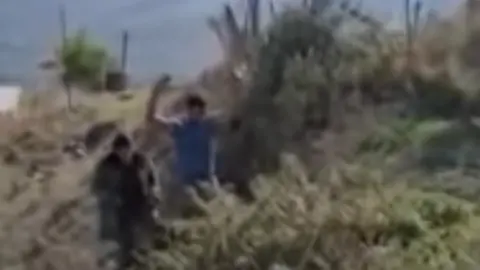 Telegram
TelegramIn the video, someone speaking Russian with a heavy Azerbaijani accent orders the men to walk forwards, surrender any weapons and raise their hands. He speaks to the other soldiers in Azerbaijani, telling them not to hit the captives.
The younger prisoner, Yuri Adamyan, removes a helmet and his jacket before putting his hands in the air and walking out of shot.
Although the older man, Benik Hakobyan, is wearing a military-style camouflage jacket, it's unclear whether he is a soldier. He is pushed to the ground and appears to moan in pain.
The first video was followed by a second that shows the apparent execution of the two men.
The prisoners appear to have their hands bound behind them and are draped in the flags of Armenia and the unrecognised republic of Nagorno-Karabakh.
They are sitting on a small wall and can be seen moving slightly. Then someone orders in Azerbaijani: "Aim at their heads." Multiple shots are heard and the prisoners slump to the ground.
Videos rejected as fake
The BBC has confirmed that the man giving commands in both videos is a native Azerbaijani speaker with a regional accent. The prisoners from the first video also appear to be the men being executed in the second as they are wearing the same clothes.
Azerbaijan's defence ministry quickly denied these were their troops and called the videos a provocation. The clips were deleted shortly afterwards.
The following day, Azerbaijan's prosecutor general announced that an investigation had concluded the videos were fake.
But are they genuine?
The BBC has studied the clips and confirmed that they were filmed in Hadrut, a town that has seen intense fighting. It is in southern Nagorno-Karabakh, near Fuzuli.
It's likely the videos were recorded at some point between 9-15 October. Azerbaijan announced that Hadrut had been taken on 9 October, although it later emerged that, while they had taken some strategic heights around the town, fierce fighting was still going on for control of the town itself on 12 October.
The first videos actually showing the Azerbaijan army in the town centre appeared on 15 October. The POW videos both appeared for the first time on 15 October.
Bellingcat open-source investigators were the first to publish their analysis into the authenticity of the videos.
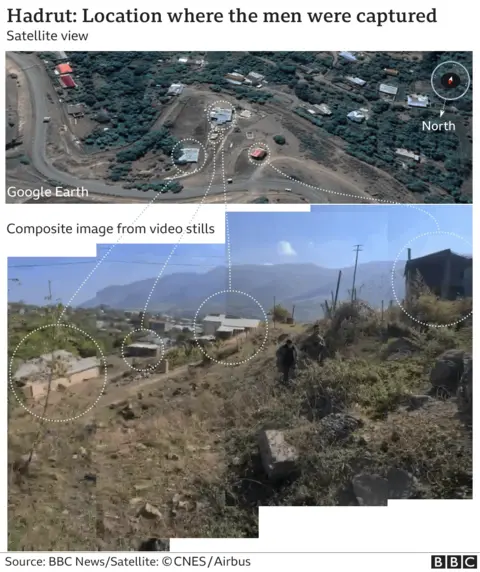

The location of the first video is the side of the road in the northern part of Hadrut (39°31'25.9"N 47°01'40.8"E).
In the picture above, there are four buildings that appear in the video that can be matched to structures in a satellite view of the region.
The execution clip seems to be filmed at a park approximately a kilometre away in the south of the town.
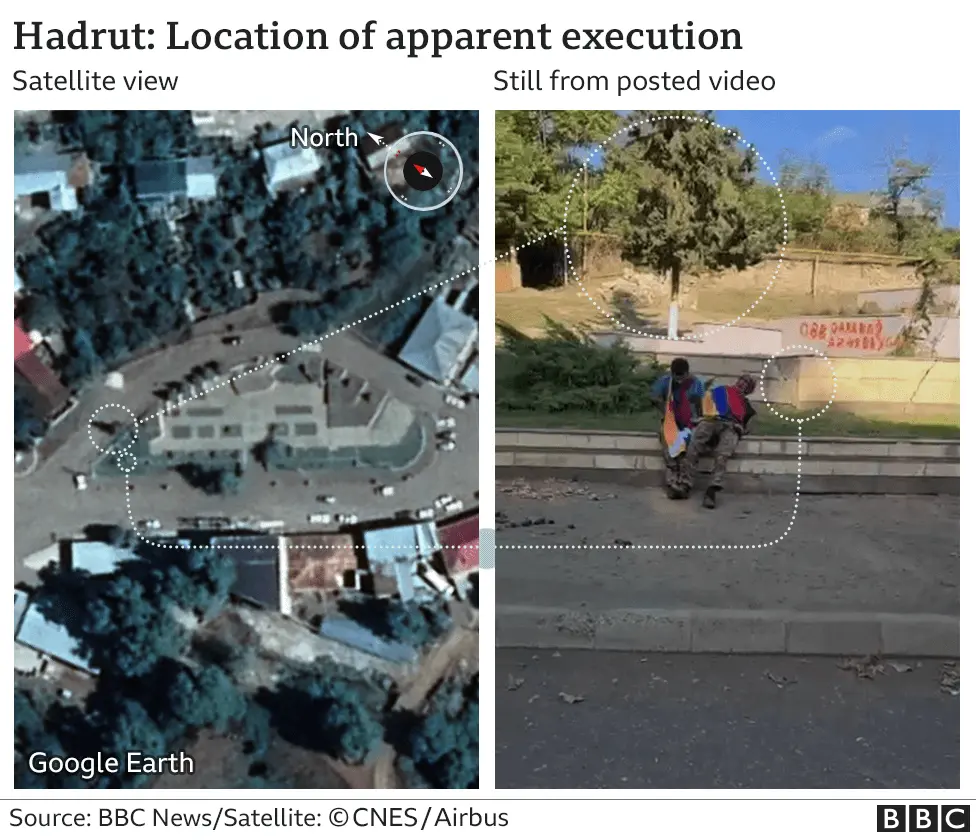

By cross-referencing a still from the video before the men were shot with a satellite view of the town and footage from a local TV report, it is possible to identify the exact location as the park next to Mkrtchyan Street (39°30'53.4"N 47°02'01.8"E).
Bellingcat identified the same locations and time periods for both videos and confirmed that helmets and rifles seen on the soldiers matched those used at least in some instances by Azerbaijani servicemen.
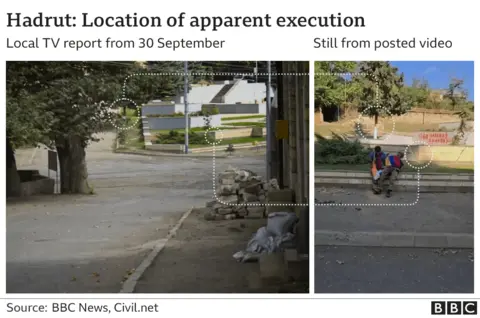

They wrote that their analysis "would appear to indicate that these two men were indeed Armenian combatants who were captured between October 9 and October 15 by Azerbaijani soldiers, possibly special forces, and likely executed a short time later".
Online commentators from Azerbaijan have questioned the authenticity of the clip, by pointing out the apparent lack of blood as a result of the shooting, but military experts interviewed by the BBC say the video looks genuine.
"Hollywood gives a poor reflection of what gunshot wounds look like," said Rob Lee, a military expert from the Department of War Studies at King's College London.
The BBC spoke to a former British military intelligence officer who agreed to talk on condition of anonymity due to security reasons. They said: "These are real bullets, this is a real killing. This is genuine, and I don't see any reason to assume it's staged."
Brain matter could be seen coming out of a gunshot wound, the officer said.
What does Armenia say?
Armenia's human rights defender, Arman Tatoyan, has officially labelled Azerbaijan's execution of two prisoners of war an "undeniable war crime".
"In these videos, members of the Azerbaijani army humiliate prisoners of war and then brutally kill them with extreme cynicism," he wrote on Facebook.
He said Armenia's representatives at the European Courts of Human Rights had already asked for copies of the videos. Mr Tatoyan said he would share the clips with the UN human rights commissioner, the Council of Europe and other international bodies.
A spokesperson for the Council of Europe's commissioner for human rights, Dunja Mijatovic, confirmed that the materials had been received and the commissioner was "closely following the situation and she will look into all allegations of grave human rights violations and take actions when she deems appropriate".
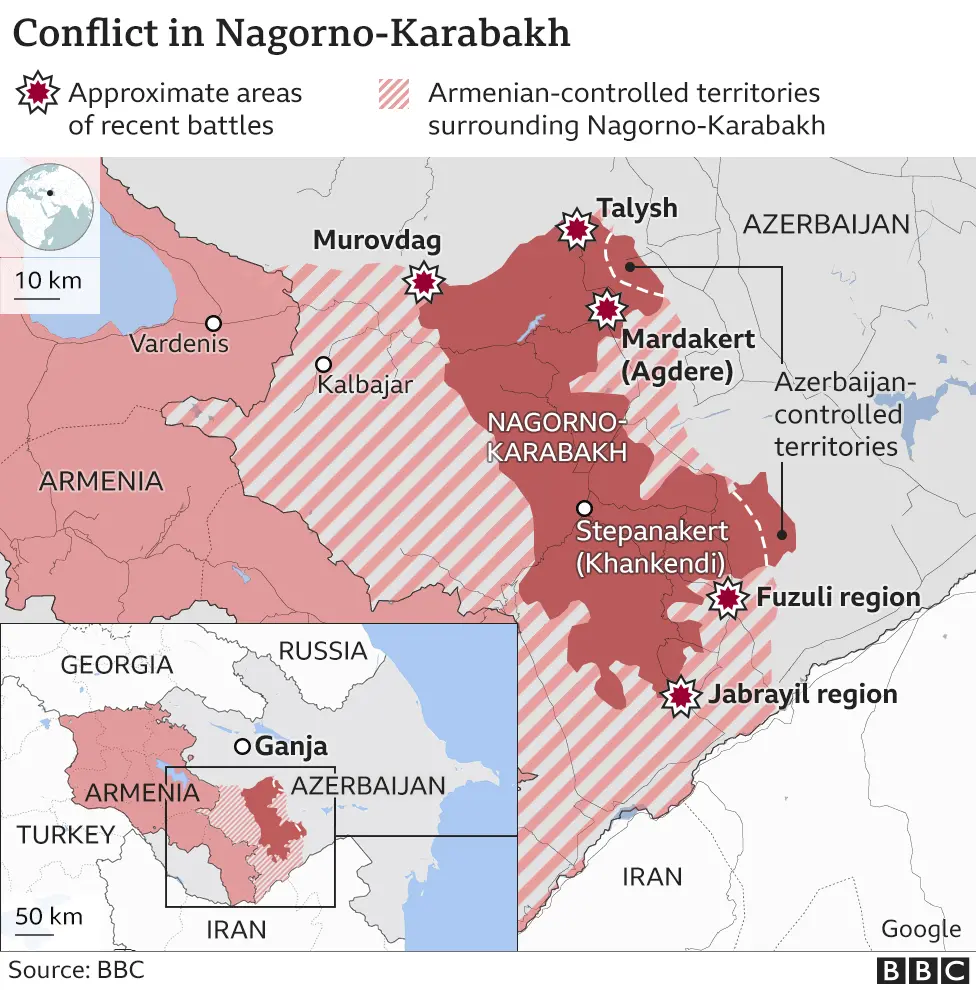

A spokesperson from the International Committee of the Red Cross told the BBC that although the organisation followed up on all such allegations, it did not speak publicly about specific incidents.
Nagorno-Karabakh human rights ombudsman Artak Beglaryan told the BBC that the men in the videos were two locals. He said Benik Hakobyan was not a soldier but a civilian from Hadrut and Yuri Adamyan was likely a serviceman from a neighbouring village.
Since the appearance of the video from Hadrut, both sides have released statements identifying several prisoners of war. Azerbaijan showed two Armenian captives receiving medical attention and the Armenians produced images of an Azerbaijani prisoner undergoing treatment at a hospital in Karabakh.

What is a war crime?
- War crimes are actions violating international rules of war as defined by the body of laws, most importantly the Geneva Conventions
- The Conventions' signatories — all UN member states, Azerbaijan and Armenia included — must protect the prisoners of war, as well as sick and wounded, from harm
- Torturing, injuring or killing such a prisoner constitutes a war crime
- The Geneva Conventions also protect civilians
- Since the escalation of the conflict on 27 September, both Azerbaijani and Armenian forces have shelled cities and towns. Dozens of civilians have been killed and hundreds injured, in what could be defined as a war crime

Find out more about the Nagorno-Karabakh conflict:
